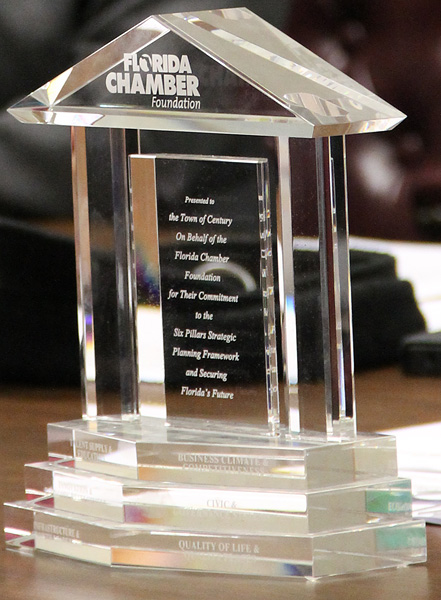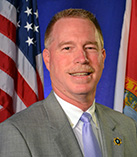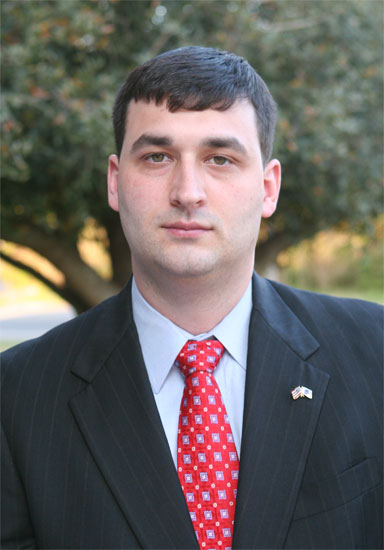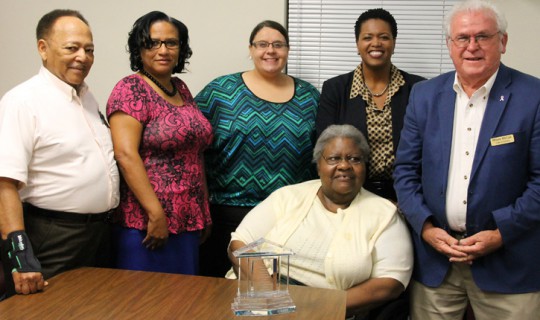Local Teachers Share $64K In Education Grants
October 21, 2014
Over $64,000 in grants were presented to local teachers Monday night by the Escambia County Public Schools Foundation as part of it annual Grants for Excellence Awards.
 “This program is especially important for Escambia County Public Schools because there are needs in the classroom that cannot be covered through existing school or district budgets,” said David Deliman, chairman of the foundation’s board of firectors. “Our Foundation’s mission is to help overcome these gaps to ensure local students have the tools and resources they need to compete in today’s competitive economy.”
“This program is especially important for Escambia County Public Schools because there are needs in the classroom that cannot be covered through existing school or district budgets,” said David Deliman, chairman of the foundation’s board of firectors. “Our Foundation’s mission is to help overcome these gaps to ensure local students have the tools and resources they need to compete in today’s competitive economy.”
This year’s grants represented a wide variety of projects, all with a focus on either STEM (science, technology, engineering, and math) areas or literacy initiatives. For example. students in Henrietta Adams’ classroom at Jim Allen Elementary School in Cantonment will read books about African art on a “multicultural safari” which was funded by a foundation grant. In Douglas Allen’s classroom at Tate High Schol, students will turn to physics toe explore the speed ratio of runners, and in the classroom of Nichole Childress at Jim Allen Elementary School, the old adage “a picture is worth a 1,000 words” will come to life with visual vocabulary cards. And at Ransom Middle, students let by Chet Truett will produce a newscast using iPads.
The following 45 projects received up to $2,000 each for a total of $64,316.82 in grants from the Escambia County Public Schools Foundation:
- Henrietta Adams, Jim Allen Elementary – Amazing African Art: A Multicultural Safari
- Douglas Allen, Tate High – Physics of Speed-Ratio of Runners
- Theresa Anderson, Oakcrest Elementary – The Read-Aloud Factor
- Sara Barcellona, Brown-Barge Middle – Astrorockets
- Edward Bauer, Washington High – Accessing the Diversity & Abundance of Nearshore Species
- Russell L. Bertles, Workman Middle – The Theory of Music-tivity
- Robin Blalock, Tate High – Of Mice and Men
- James Bobbitt, Pensacola High – Visualizing Polynomial Graphs using Graphing Calculators
- Adam Bretschneider, Roy Hyatt Environmental Studies Center 3– Experience the WildCAT: A Hands-on FCATE Ecology Review
- Sherri Carter, Bratt Elementary – Flip Classroom to Success
- Nichole Childress, Jim Allen Elementary – Visual Vocabulary Cards: A Picture is Worth 1,000 Words
- Heidi Chism, Pine Meadow Elementary – Reptiles! Reptiles! Reptiles!
- Tim Deloge, Escambia High – NASA Human Exploration River Challenge
- Diedra Diettel, Suter Elementary – Eggstra! Eggstra! Learn All About It!
- Ann Dungan, Blue Angels Elementary – Bullying? Not At Our School!!
- Patricia Gaddis, Tate High – Video Variations and Explorations
- Melissa Garcia, Semmes Elementary – Differentiating Literacy and Math Education
- Krystal Gibson, Beulah – Genius Hour: Engaging Students by Igniting Their Passion
- Rachel W. Gilmore, Molino Park Elementary – Reading/Writing Round-Up
- Kathy Godwin, Semmes Elementary – Bringing the World to Life
- Anna K. Harageones, Ferry Pass Elementary – Help Young Readers & Writers Build a Robust Vocabulary
- Brenda Harrell, Bratt Elementary – Picture a Word
- John Herber, Oakcrest Elementary – The Little Planet that Could
- Janet K. Johnson, Pine Forest High – Promoting STEM and Social Studies Literacy
- Maurine Kramerich, PATS Center – Historical Sculptures and Monuments
- Michelle Leitner, Semmes Elementary – Learning Literacy through Listening Centers
- Peter N. Lupton, Pine Forest High – Getting to Know the World Around Us
- Matthew MacGregor, Escambia High – Citizen Science
- Melissa G. Marsh, Pensacola High – ELL Literacy Project
- Sarah Mason, Blue Angels Elementary – Transformers: More Than Meets the Eye
- Kevin McAuliffe, Pine Forest High – A Story with A Different Voice
- Vicki Murphy, Oakcrest Elementary – English Language Learning Going Digital
- Jean Odom, Cook Elementary – Sesame Street Puppeteers Set the Stage
- Nancy O’Neal, Ransom Middle – LEAP into Science
- Karen Potter, Ransom Middle – Practice Makes Better Readers
- Catherine Rudd, Scenic Heights Elementary 3– Literacy through Comic Books
- Caitlin Salak, Beulah Elementary – STEM Challenges for 5th Grade
- Mary Samaras, Cordova Park Elementary – All Dressed Up and So Much to Learn
- Anita Schmidt, Lipscomb Elementary – Student Advocacy: Protecting Shore Birds
- Lorri Seibert, Ransom Middle – Tools of Engagement
- Jane Smith, Longleaf Elementary – Providing Anywhere, Anytime Learning
- Cindy Speed, Weis Elementary – Students for STEM
- Melissa Thompson, Scenic Heights – Interactive Science Notebooks
- Chet Truett, Ransom Middle – Reporting to You LIVE!
- Shawn P. Walker, West Florida High – Oh Brother, Give Me Color
- Roberta D. Wetzel, Bailey Middle –1 Let’s Explore Courage in Life and Literature
The projects funded this fall will directly impact a total of 11,237 students and 220 teachers this school year alone, organizers said. Many of the classroom materials, software, and other items purchased with Grants for Excellence funds will continue to be used for years to come.
Florida Chamber Award Presented To Town Of Century
October 21, 2014
The Florida Chamber Foundation honored the Town of Century Monday night for their commitment to regional economic development.
 The town received the “Six Pillars Award” for the completion of the Century strategic plan to help the community create jobs and opportunities for business and families.The award was presented by Gulf Power Vice President Bentina Terry, who is also the Florida Chamber Foundation Board of Trustees chair, at a regular town council meeting.
The town received the “Six Pillars Award” for the completion of the Century strategic plan to help the community create jobs and opportunities for business and families.The award was presented by Gulf Power Vice President Bentina Terry, who is also the Florida Chamber Foundation Board of Trustees chair, at a regular town council meeting.
“I am pleased to welcome the Town of Century as the newest Six Pillars Community,” said Terry. “Their commitment to improving their economic competitiveness in all areas of the six pillars framework will not only benefit this region but will add their vision to the work of other communities throughout Florida.”
The Florida Chamber Foundation Six Pillars framework serves as an organizing force for strategic planning at local, regional and state levels.
The Town of Century Six Pillars plan includes a number of strategic goals, including:
- Leading the region in rural economic competitiveness and rural community revitalization, and
- Proactively leading the region in the development and delivery of innovative and relevant workforce training programs.
Century – Heart and Soul: This was the second story is a two-week series on NorthEscambia.com featuring Century.
Pictured top: (L-R) Council members Gary Riley, Sandra McMurray Jackson, Jacke Johnston; Florida Chamber Foundation Board of Trustees Chair Bentina Terry; Mayor Freddie McCall; and (seated) council member Annie Savage. NorthEscambia.com photos, click to enlarge.
Early Voting Begins With 1625 Ballots Cast In Escambia County
October 21, 2014
 Monday was the first day of early voting in Escambia County, with 1,625 total ballots cast.
Monday was the first day of early voting in Escambia County, with 1,625 total ballots cast.
In North Escambia, there were 97 ballots cast in Molino, 250 at the Extension office is Cantonment.
Earl voting continues at seven locations until Saturday November 1:
- Molino Community Center, 6450 Highway 95A North, 9 a.m. to 6 p.m.
- Escambia County Extension Services, 3740 Stefani Road, 9 a.m. to 6 p.m.
- Genealogy Branch Library, 5740 N. 9th Avenue, 9 a.m. to 6 p.m.
- Main Library, 239 N. Spring Street, 9 a.m. to 6 p.m.
- Bellview/Saufley Early Vote Site, 4607 Saufley Field Road, 9 a.m. to 6 p.m.
- Supervisor of Elections Main Office, 213 Palafox Place, Second Floor, 8 a.m. to 5 p.m.
- Southwest Branch Library, 12248 Gulf Beach Highway, 9 a.m. to 6 p.m.
Back in 2010, there were 1,104 ballots cast on the first day of early voting.
Sweet Math Project: Northview Students Supersize Candy
October 21, 2014
Geometry students at Northview High School recently completed a really sweet project — scaling ordinary candy packages into supersized replicas. The completed projects are currently on display in the school library. NorthEscambia.com photos, click to enlarge.
Five Questions For Florida DOC Secretary Michael Crews
October 21, 2014
Gov. Rick Scott tapped Florida Department of Corrections Secretary Michael Crews two years ago to oversee an agency that is responsible for more than 100,000 prisoners and supervises nearly as many people in the community.
 Crews, who has a bachelor’s degree in criminology from Florida State University, started his law-enforcement career 30 years ago as a correctional officer at Apalachee Correctional Institution. Crews spent 27 years working his way up the ladder at the Florida Department of Law Enforcement before returning to the corrections department, this time as assistant secretary, in 2011.
Crews, who has a bachelor’s degree in criminology from Florida State University, started his law-enforcement career 30 years ago as a correctional officer at Apalachee Correctional Institution. Crews spent 27 years working his way up the ladder at the Florida Department of Law Enforcement before returning to the corrections department, this time as assistant secretary, in 2011.
Crews began his tenure as corrections chief with a $100 million budget deficit. Things worsened this year after reports of inmate deaths, abuse by guards and cover-ups in the department. The Department of Law Enforcement is now investigating more than 100 suspicious inmate deaths, and the FBI is looking into possible wrongdoing at several state prisons. Black leaders are also asking the Justice Department to scrutinize prisoner deaths. A group of corrections department investigators sued Crews and others earlier this year, alleging retaliation for exposing a cover-up surrounding the death of an inmate at a Panhandle prison two years ago.
Five questions for Michael Crews:
Q: Your department is under intense scrutiny because of a number of inmate deaths, as well as alleged cover-ups surrounding those deaths. What do you say in response to those investigations, and what can you say to the families of the 100,000 inmates in your care to assure them that their loved ones are safe?
CREWS: The first thing I want to say is I think it’s unfair that the agency as a whole is painted under the same umbrella of all being corrupt and non-transparent. A lot of those words have been used in a lot of the stories that have been written about us. The fortunate thing for us in this department is that 99.9 percent of the men and women that work here are good, hardworking, decent people. They come here to work every day, do their jobs. They do it with integrity. They do it professionally. And it’s somewhat unfair, although I understand that this is not just about the Department of Corrections. That seems to be the mindset of society as a whole. But there is a very select, few people who have either made conscious decisions or taken deliberate actions, allegedly, and conducted themselves in a way that we say is unacceptable in this department. They’re the reason we are in the position we are in today, because of that select few.
It is somewhat human nature for people to think that when you have some of the things that are going on in the agency that we’re looking into right now that it is a cultural issue. What I would say to those people is that maybe it’s cultural but it’s cultural within that select few people. It’s not cultural in this agency. The reason I’m confident and I can say that is because, knowing the times we’re in, knowing some of the challenges that we face in this agency, I hate to think of where we would be if we didn’t have the quality of the people we have working in this agency.
We’ve also made it pretty clear, for the last several months as I’ve traveled around this state and I’ve met with the leadership teams at all 49 of our institutions about what our expectations are as it relates to conduct if you’re going to work for the Department of Corrections, and that conduct’s not only while you’re on duty, that conduct’s while you’re off duty. We made a statement that we’re not going to tolerate anything less other than being the highest professional, integrity-based individuals and agency in this state and in this country.
It’s unfortunate sometimes that people do elect to go outside of those expectations and those goals of how you’re going to conduct yourselves and how you’re going to do business. We’ve said all along, and we made this point at each of those 49 stops, we’re going to have zero tolerance for inmate abuse. Period. We’re not going to allow it. What we have to continue to do is make sure that our staff understand that when they see, witness or are exposed to something that they know is fundamentally, morally or legally wrong, they have a responsibility to report what they saw up their proper chain of command. What I’ve told them, I gave them my word there will be no repercussions or retaliation for people wanting to come forward and do the right thing. I’ve also said that I can’t make everybody like them. But I can protect them. I want them to feel and understand that that’s how we get better. We hold each other accountable. I’m going to hold our staff accountable and likewise I expect them to hold me accountable. And as long as we’re all doing that, we are going to get to where we want to be as an agency and that is to get to a respectable agency that people understand we know what we’re doing and we’re doing it the right way because it’s the right thing to do, not because somebody’s looking at us.
Q: You say there won’t be any repercussions, but that is part of the culture. People get dead animals in their mailboxes. Their cars get keyed. Their colleagues don’t come to respond when they call for help. You may not retaliate against folks when they come forward but doesn’t it take time for that message to trickle down and for those behaviors to change?
CREWS: There’s no doubt there are still people who work in this agency that are fearful of coming forward for doing the right thing. There’s no doubt in my mind about that. We didn’t get into the position that we’re in today overnight. We’re not going to get out of it overnight. This takes time. And when you’re trying to change a culture you have to do it from the top down and the bottom up. Because if you segment either one of those and say we’re just targeting the wardens or we’re just targeting this group and it’s not inclusive of everyone and everyone doesn’t understand that this is the way we do business, you’re never going to change that cultural aspect. It has to be collectively as a whole. That’s what we’re attempting to do. In those meetings, there were a lot of people. … When I say leadership teams, we were pretty comprehensive as we went about this. The message I delivered to them, the expectation was that same message was to be delivered to all of our 22,000 staff across the state.
Actions are worth 1,000 words. It’s easy to say it. Where we start making positive gains and positive movements in this area is when we do have people who are willing to come forward and stand up for doing the right thing. It’s those people then that we want to publicly recognize and say this is the type of conduct not only do we expect but this is what we’re going to recognize. That is a huge hurdle to overcome, just knowing some of the things that have gone on in the past. If we could predict human behavior, we’d probably all be doing something else. You just can’t.
As hard as you try through your hiring processes, your selection processes, to get the best people, people are humans. People are tempted. People do make mistakes. What I promised our staff is that there is a significant difference in people making a mistake and people doing something deliberately to embarrass or discredit this agency. You and I are going to make mistakes every day. I probably made a handful before I got here this morning. I’ll probably make another handful before I get home tonight. What we have to do for those people is, when they make decisions that maybe they weren’t the best decisions or in the best interest, we owe it to them to make sure we pull those people in and say, “Listen. Let’s talk about what happened. Let us help you learn so that the next time this happens you make a better decision.” There’s a huge difference in that and someone who goes out and intentionally does something to discredit because of their conduct, how they behave, how they treat an inmate or how they treat another staff. There’s a huge difference in that. And the group in the latter half, that smaller group I talked about earlier, we’re not going to tolerate them in our agency.
The real frustrating thing is that you’ve got a select few. Their actions reflect on all 22,000 of us, all 22,000. But they don’t represent who we are. We’re not going to let them drive the direction we’re going to go in this agency. When we identify those people, and we have good, credible information and we come to the end result of an investigation and we determine that someone has done something outside of what we’ve said is allowable or justifiable or even legal, then we’re going to deal with those people as expeditiously as we can and make sure that they find someplace else other than this department to work.
Q: A few more inmates died last week. That brings the total to more than 116 unresolved deaths under investigation by the Florida Department of Law Enforcement. Some people are questioning how this can still be going on with all of the attention on the agency. Is this just what normally happens and if it hadn’t been for these high-profile cases no one would be paying attention to it? Or is there a bigger issue here?
CREWS: Great question. I would ask people to think of it this way. I didn’t look at it this morning but my guess is if you pick up the Tallahassee Democrat, there’s a list of obituaries. A number of people died. We have people in our prisons. We have over 101,000 today. People are going to die. We also have an aging population in our prisons. People that were 60 years old 10 years ago, now they’re 70 years old. Institutional life, or prison life, is a hard life within itself. When you have all those factors coming together, we’ve had people dying in our institutions since we’ve had institutions. That’s not anything new. When your population grows, when you have part of your population that becomes older, those factors all contribute perhaps to the number of deaths that you have. Now, do the numbers go up? They do. I know about all of these deaths from when they occur now because we made a change in our protocol. Every inmate death, now, that occurs in our institutions a couple of things are going to happen. One is, I’m going to be immediately notified. I get calls at all hours of the night and early morning saying here’s what happened based on the facts that we know at that time. On every death that’s occurring in our institutions now, the department’s office of the inspector general is notified, FDLE is called to come in and then the medical examiner’s office from the respective area is going to come in. I think that was a very positive step for us because I would hope that it would give the general public an idea that we are going to be open and transparent. We’re not going to hide anything. It gives us the opportunity to utilize the services of the Florida Department of Law Enforcement to come in as almost an independent review in addition to (what) the office of our inspector general would be looking at.
Ultimately, at the end what we want to get to is the truth. We want to know what did happen. We want to know was it a natural cause, was it accidental, was it a suicide, or was it another type death that we had perhaps people acting outside the norm of what we say is allowable or justifiable, so that we can then make decisions based on fact. What I’m not willing to do is make decisions based on what the rumor mill is or what somebody thought they heard or saw. We’re going to base our decisions on factual information that comes from investigations, medical examiner’s findings. I would hope that’s the way everybody wants to be treated. Everybody should be afforded due process. That’s part of what we have by soliciting FDLE to come in. You then take all of that information and you get to the truth. Then based on the truth, it’s incumbent upon me, if there were things that were not done properly or people that did not act properly and misconduct was there, that’s my responsibility to make sure those things are rectified. But not based on what somebody says they think they heard two weeks ago. That’s not fair to you, me or any of our staff or anyone else. We’re going to base our decisions on fact.
Q: Is what you’re doing enough to instill trust in the public that people are safe when they get incarcerated?
CREWS: I hope it makes a difference. I really do. I hope the general public understands some of the things we’ve done proactively — bringing in FDLE to help with investigations, putting a real emphasis on mental health of inmates, increasing our crisis-intervention training, putting in place a certification program for mental-health units. We’re going to be hiring an ombudsman who is going to be solely dedicated to give those inmates who have mental health issues a voice, someone they can go to when they feel they’re being treated wrong or they’re not being treated properly. I would hope also that that ombudsman will give the families of those inmates an opportunity to reach out.
So I would hope that the general public would see that we are being proactive. Do I think it’s enough? The results will prove that as we move down the path. Are we making some significant differences today? Yes. I am 100 percent confident of that. We didn’t get here overnight. We’re not going to get out of it overnight. This is a marathon, not a race. What’s incumbent upon us, as leaders in this agency, is to make sure that we continue to do and evaluate and look at all of our practices, protocols, policies, procedures and everything that we have to make sure that we’re maximizing the safety of our staff, our inmates and the general public who comes into our institutions, that we’re conducting ourselves properly and within the realm of what we say we expect and that we treat everyone fairly and respectfully. Getting to that point, once we get there — I don’t know that we’ll ever stand up one day and say we’re there — but I think we’ll know it.
But I am confident that we’re making some significant changes in this agency on things that for a long time perhaps weren’t addressed. Maybe they should have been. I don’t know. But this agency has been around a long time, a lot of history. And when we began, this agency, as most correctional systems were, was viewed as a warehouse for inmates. As long as you kept those that were sentenced to prison behind the fence, from an institutional perspective, you were considered doing a good job. Our statutory responsibility is the care, custody and control of inmates. We do a great job with the custody and control. Where we’re really focusing a lot of our efforts now is on the care part, because that’s typically where you wind up getting yourself in trouble.
Being sentenced to prison is the sentence. There should be no other sentences once you get there. I know there’s different views and opinions. Some say if you didn’t want to go to prison, you shouldn’t have committed the crime. Well, you know people do commit crimes. People make mistakes every day. And it’s our job to make sure that those who come into our custody, that we protect them as best we can, that they’re safe and in a safe environment and that our staff treat them safely and we also maximize the safety of our staff who are working in one of the most difficult jobs you can ever work in.
Q: You have a re-entry prison now. What are you doing to prepare inmates to go back into the community?
CREWS: Outside of our operational issues, re-entry and our transitioning from prison to community initiative is our highest priority. If you think of it in these terms, in just sheer numbers, that 101,000 inmates that we have currently incarcerated, at some point about 89 percent of those individuals are going to be released. When they’re released, they’re going to come back into our communities. They’re not going to go to the community for ex-inmates and ex-felons. They’re going to come in your neighborhood and they’re going to come in mine. Their children are going to go to school with our children. They’re going to be in the same gas line and the same grocery store line that you and I are in. So we can stick our heads in the sand and say, “Re-entry doesn’t apply to me.” Well, if they move next door to you or your grandchild or your granddaughter or your grandfather, it does apply.
What we’re trying to do is to make sure that when those inmates are released back into society that we have done everything we can to prepare them to be successful, productive citizens back into the community, to keep them from coming back into the system again. How do you do that? One is you’ve got to get them an education. About 70 percent of the inmates who come into our system have no formal education at all. It’s incumbent upon us to keep pushing forward with our GED programs. It’s also helpful if you can get them a vocational skill that meets the needs of what the demands are in the community now. That’s why we work closely with industries to look at the current needs and future needs for vocational-type skills. It really doesn’t do us any good to have plumbing-certification programs if there’s not going to be a need for plumbers. We work with those industries to see if we need to change our programming to be able to give them a vocational skill.
So many of our inmates, almost 80 percent, have some form of substance abuse. I won’t say all, but the vast majority of individuals who are incarcerated in our system right now — they may be in there for a burglary or a theft or whatever — but if you look down to the root cause of what made them do that, there’s some form of substance abuse. That is the root of so much of what we see. We’re doing everything we can. Are we where we need to be? Absolutely not. Honestly, in re-entry, I don’t know that we’ll ever be there. Continuing to build some of the partnerships we have in the community to provide the resources they need, we’ll continue to do that. We’ll foster new relationships and build on the old ones we have.
Right now, there seems to be a little bit of a gap between when an inmate is released and when they go back into society from this standpoint. Individuals that are released from custody in an institution that have some form of supervision to follow — probation, parole, whatever it is — we still have authority and the ability to direct and get them to that mental-health appointment, that substance-abuse appointment, set them up with a job-placement group to help them get employment. Those individuals that the end of their sentence comes and they have no supervision to follow, it’s their decision then whether or not they’re going to take advantage of all of those appointments. What we’re trying to do now is figure out how we bridge the gap for those people to give them the ability to have access to what they need that minimizes some of the obstacles that they face. There’s a lot of them out there. One of the areas we’ve focused on is making sure that inmates that go out of our system have an ID card. That’s been a big push for us. What we heard around the state in our town hall meetings, that was one of the biggest nemesis.
Even if an inmate has everything — an education, a vocational skill, an ID card, they’re getting their treatment — the fact that they’re an ex-felon is an obstacle within itself. There just are not a lot of people out there who are willing to give these individuals a chance to have a job, to be able to earn a paycheck, to be able to rent a place or buy a place. What we’ve got to continue to do is say everyone does make mistakes but some of these people deserve a second chance. They’ve served their time. The more we can get our communities involved, whether it be from the employment side, the faith side. … But where we really have to make sure we’re focusing on is making sure that family reunification is there. So many of the inmates we have that are released don’t have that family bond to go back to. That is a critical component for them, having that safe environment, someone they can rely on until they get their feet set and a little bit situated.
(People might be surprised at the amount of empathy you’re expressing for the people in your custody.)
I do care. If I am the family of a victim of a crime I probably feel a little bit differently about that. My view is probably my loved one didn’t have a chance for that or my loved one didn’t have the opportunity to continue to move forward in life. I respect that wholeheartedly. In our system, we have three different classifications of inmates. This isn’t anything formal. This is just my view. You have a group over here who made a mistake and they’re serving their time. Quite honestly, we really don’t have to do much for them. They’ve learned their lesson. The time they’re serving is hard. When they come out, they’re not going to come back to us. You’ve got a group on the other end of the scale that no matter what we do for them it really doesn’t matter. Pretty shortly after being released, they’re going to commit a new crime. But in the middle of our population — there’s probably 60 to 70 percent of them — that one, a large if not vast majority of them came from broken homes. They didn’t know who their father was or have a father figure, and they were exposed to some conditions or environments that, had you or I been exposed to, we probably would have been in the same situation.
I do care. … People a lot of times get caught up in saying I have an interest in dropping the recidivism rate — the number of inmates who return within three years — because there is a cost savings. And there is. For every 1 percent drop in recidivism rate there’s a cost savings of $19 million spread out over five years. And that’s nothing to sneeze at. I mean, that’s important. But we’re doing what we’re trying to do in re-entry because it’s fundamentally and morally the right thing to do. Yes, there are people who have committed some horrific offenses and crimes in this state. No doubt about it. And again, there are some of those that there’s just not much we can do to help them. But we do have so many of our population that we can help. When we can help them to go back into society and they don’t commit a new crime, the greatest thing out of them not committing a new crime is there’s no new victim. When you’re talking about victims, you can’t put a dollar on the cost to the person who was subjected to that crime. I’m proud to say we’ve got a 43-year low in crime in this state right now. That’s a significant accomplishment due to the hard work of the criminal-justice professionals in this state and our Legislature and the governor. But when we can reduce the number of victims and we can stop people from going out and two years later coming right back in our system, that’s a win for all of us. Everybody in this state wins when we’re able to do that.
We’re going to do our part to make sure that while we have them in custody that we do everything we can to prepare them. We release about 32,000 inmates a year that go out into the communities. The average age of our inmates right now is about 33 years old. The average inmate serves about a three-years, two-month sentence. The average education level is sixth grade. So for every inmate we have that has a high school or college degree, we have somebody that from an educational- and mental-capacity level, is a kindergartner. That’s tough. That’s tough when you’re trying to effect change and get inmates and people to understand. We can give them all the programs in the world. But they too, have to have some ownership in this. They have to want to change. And they have to want to change inside to understand that there are other ways to be productive in society rather than being a criminal. And the second piece of that is we have to give them the skills to do that, whether it be educational, vocational, treatment programs, whatever it is. So many times we take for granted what they really need.
You take an inmate who’s been incarcerated for 25 or 30 years. How to balance a checkbook, how to parent, how to write a resume, how to interview for a job — they have no clue because for 24 hours a day, seven days a week, for the last 25 years, they’ve been told when to get up, when to go to sleep, when to get dressed, when to take a shower, when to eat. It’s very structured and very disciplined. Then the end of their sentence is going to come and we’re going to send them outside that gate and if they don’t have something that they feel confident they can pull back and rely on to help them begin to build their new life, they’re going to revert back to what they know best, which is committing crimes. That’s the cycle we’ve got to break. I’m proud we announced two years ago that our recidivism rate dropped from 33 percent to 27.6 percent in this state. I’m proud of that. And we’re continuing to drop that number even more because, if we’re doing that, then we’re making a positive difference not only in that inmate’s life, but we’re making our lives better, too.
by Dara Kam, The News Service of Florida
Escambia (AL) Sheriff Candidate Heath Jackson Endorsed By Arizona Sheriff Joe Arpaio
October 21, 2014
 Heath Jackson, Republican candidate for sheriff of Escambia County, AL, announced Monday that he has been endorsed by “America’s Toughest Sheriff,” Maricopa County, Arizona Sheriff Joe Arpaio.
Heath Jackson, Republican candidate for sheriff of Escambia County, AL, announced Monday that he has been endorsed by “America’s Toughest Sheriff,” Maricopa County, Arizona Sheriff Joe Arpaio.
“I’m honored to have the endorsement from Sheriff Joe Arpaio,” Jackson said. “Sheriff Arpaio has a reputation throughout the country as one of toughest, hardest working members in law enforcement and I am proud to have his support.”
Arpaio’s endorsement was as follows:
“I know the importance of conviction, dedication, professionalism, and the strength it takes to serve in law enforcement. That is why I am happy to endorse Heath Jackson in his run for Sheriff in Escambia County. Heath has worked tirelessly in Alabama and Florida to take drugs off the streets and put drug dealers behind bars. He has worked aggressively as a narcotics investigator and spearheaded countless high-profile investigations that resulted in the successful arrests and prosecutions of criminals involved in drug trafficking, organized crime, prostitution, and violation of gun and explosive laws. I hope the good people of Escambia County will join me in supporting Heath Jackson for Sheriff.”
Arpaio is tae six-time elected sheriff . Known throughout the country as one of America’s toughest sheriff’s, Arpaio has been featured and profiled thousands of times by worldwide news media. Arpaio is a leading voice in the debate against illegal immigration and is known for unapologetically punishing those who break the law in his county. He is famous for building “Tent City,” an extension of the Maricopa County Jail that houses prisoners in un-air conditioned, outdoor military tents, despite Phoenix’s extreme heat and for requiring inmates to wear pink underwear and undershirts.
Florida DEP Open House For Home Buyers, Real Estate Agents, Developers
October 21, 2014
The Florida Department of Environmental Protection’s Northwest District invites real estate agents, developers and potential home buyers to an open house on Wednesday, October 29 in Pensacola.
 The open house is designed to answer questions about state-permitting requirements, property restrictions and cost-saving measures in order to help buyers make informed purchasing decisions.
The open house is designed to answer questions about state-permitting requirements, property restrictions and cost-saving measures in order to help buyers make informed purchasing decisions.
The department has a wealth of information about wetlands, waterfront property, docks and marinas, lift stations, asbestos, site contamination and more. DEP experts will be available to answer questions and demonstrate online resources. In addition, several presentations are scheduled throughout the day to provide an in-depth overview of some of the most common topics.
The event will be held from 10 a.m. – 2:30 p.m. on Wednesday, October 29 at DEP’s Northwest District Office at 160 West Government Street, Suite 502 in Pensacola
For agenda and registration details, click here.
Owe Santa Rosa County Money? There Are New Payment Options
October 21, 2014
Customers owing money to Santa Rosa County can now establish payment plans using automated withdrawals from their checking account or credit card.
“We want to make it as easy as possible for the customer to meet their court obligations. By signing up for this program the customer no longer has to come to the Courthouse to make their payment, pay postage to mail in their payment, or worry about missing their payment. It is a good program for our customers,” said Clerk of Court Don Spencer.
Both methods allow the customer to set up their withdrawal plan without worrying about missing payments. The customer’s authorized pre-agreed upon amounts will be deducted on the same day of each month from their checking accounts or charged to their credit cards. It is easy to establish, resolves the late payment fees issue and the customer does not need to remember the payment due date. On a monthly basis, the participant will receive a recorded phone message from the Clerk’s office reminding them of their automatic bank draft or credit card charge.
When the customer’s account is paid in full withdrawals are stopped and the customer’s file is closed.
If a customer wants the automated process to stop they should send their written request to the Santa Rosa County Courthouse. The request should be mailed by the customer so that it arrives at least five days prior to the next withdrawal date. Questions can be directed to the Courthouse Information Desk at (850) 981-5554.
James T. Ward
October 21, 2014
James “Jamie” T. Ward was born May 1, 1966, and lost his life in a car accident on October 5, 2014. He as the 48-year old father of three and Poppi (grandfather) of three, a beloved husband and friend of many. He was born in Atmore but resided in Molino.
His favorite pastimes were hunting, fishing and college football. He loved all sports including softball which he played for over three years and was an avid Alabama football fan. ROLL TIDE! He was currently enrolled in a small engine class at Tate andd formally a driver for produce and appliance delivery. Jamie was a hard-working, joyful man who loved his family more than anything and would have done anything to protect them.
He was preceded in death by his father, Ray Ward; brother, Ronnie “Chicken” Ward; and grandparents, Tom and Winnie Ward.
Jamie is survived by his mother, Jean Ward; wife, Roxanne Ward; daughters, Carly Ward & Brandy Ishee; son Jacob Ward; three grandchildren, Hagen, Johnathan and Yazmin; brother, Donald “Pete” (Sharon) Ward; sisters, Debbie (Edward) Earwood, Darlene (Kenneth) Shaw; sister-in-law, Deirdre (Steve) Everett; mother-in-law, Betty Wade; uncles, Lonnie, Wayne and Willie Ward; aunt, Ruthie Neal; and numerous cousins, nieces and nephews.
A memorial service will be held at 2 pm.. on Thursday, October 23, 2014, at Faith Chapel Funeral Home North.
The family request in lieu of flowers that donations be made on behalf of his children, Carly and Jacob Ward to a fund at Regions Bank.
Faith Chapel Funeral Home North, 1000 South Highway 29 in Cantonment is in charge of arrangements.
Northview FFA Receives National Grant For Poultry Project
October 20, 2014
The Northview High School FFA has received a Local Program Support Grant sponsored by the National FFA Alumni Association.
The $1,000 grant will enable to group to complete a “Backyard Poultry” project.
The grant will be presented during the awards session of the National FFA Alumni Convention on Thursday, October 30 in Louisville, KY.







